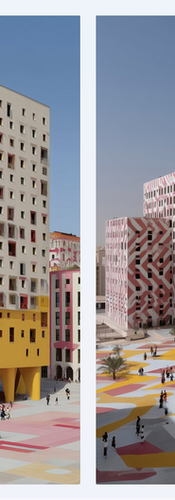October 17, 2025 - Surjan Super School Weekly Newsletter - PART 3
- SURJAN
- Oct 17
- 4 min read
SURJAN SUPER SCHOOL NEWSLETTER PART 3
WEEK OF OCTOBER 17, 2025
Title: “Forests of Architecture: The Vertical Grove, the Color City, and the Geometric Canopy”
1. The Rising Canopy
This week’s closing chapter turns its gaze upward. Massive canopies — red crowns held aloft by golden trunks — stretch across landscapes that seem to belong to both the desert and the dream. Their undersides glow like living suns.
Here, architecture has become arboreal.These monumental “tree-buildings” are not built to house people but to shade them, to redefine scale through generosity rather than enclosure. Beneath the glowing canopies, cities gather in color: plazas, stairways, and amphitheaters designed for pause and wonder.
The trees are not symbolic. They are structural metaphors for coexistence — each one absorbing light, air, and attention, creating civic spaces beneath their radiant umbrellas. Their red crowns float like coral reefs in the atmosphere, turning the city into a submerged garden of sky.
2. Civic Forests of the Future
In the next sequence, the forest becomes a civic typology. The same golden trunks multiply, forming immense grids across plazas the size of neighborhoods. The orange and yellow skies behind them pulse with a surreal intensity — an architecture of sunlight rendered permanent.
Each trunk is a vertical commons: part column, part ecosystem, part archive. The spaces between are public theaters of gathering — slow zones of walking, talking, and watching the world unfold.
From afar, they resemble cathedrals. Up close, they feel like the memory of shade after centuries of heat.
3. The Shingled Color Houses
Parallel to these open-air forests, a quieter architecture takes shape — a series of small, pitched-roof buildings with façades composed entirely of color.Each house is a geometric monolith — brown, blue, orange, or silver — split in half by a vertical seam of shadow or a diagonal cut of sun.
They are laboratories of hue, each volume acting as a study in tone and texture.The sequence becomes a meditation on material uniformity — how a single gesture, repeated with variation, can build a chromatic neighborhood of pure visual rhythm.
The simplicity of the form is deceptive: behind every door lies a different microclimate, a different emotional temperature of color and light.
4. Cities on Stilts
From intimate color blocks, the scale jumps again to floating megastructures. Vast yellow towers rise on improbable stilts, casting patterned shadows on civic squares painted with graphic energy.
These are uplifted cities — gravity-defying architectures that hover above plazas designed as fields of play. The ground itself becomes ornament: a living mural of orange, pink, and yellow geometry, where people stroll as though walking across a painting.
The buildings above — cubic, perforated, playful — rest on elongated yellow columns that seem to vibrate in the air. They are both absurd and profound: vertical cities performing balance as a civic act.
Architecture here is no longer static; it is kinetic optimism.
5. Patterned Ground, Playful Skies
The plaza imagery that follows expands the idea of city-making through color. Facades are dressed in zigzags and optical rhythms. Towers wear chevrons, crosshatches, and stripes — echoes of postmodern façadism reborn through surrealist clarity.
The ground and wall exchange roles. The plaza becomes painting, and the building becomes frame.Children and adults alike inhabit this chromatic world without hierarchy — their shadows part of the composition.
These places feel designed not for commerce but for choreography. A city remade as a living dance floor of geometry.
6. Central Park as a Polyhedral Planet
Then, the narrative zooms outward: aerial and axonometric renderings transform familiar urban grids — New York’s orthogonal logic — into crystalline mosaics. Central Park becomes a kaleidoscopic field of triangles, an artificial ecosystem where every geometric shard represents a species, a climate, or a season.
In the next frame, the polygonal map extrudes into three dimensions — clusters of faceted domes rising from the forest canopy like biomes of color. The rigid Manhattan grid dissolves into a symphony of ecological tessellation.
It’s as if the city has finally learned to speak nature’s language — not through imitation, but translation.
7. Suspended Gardens and Floating Libraries
The final sequences return to the vertical forest — but now the trees are inverted.Massive rectangular canopies float above the sea, supported by golden columns that rise like flutes. Underneath, civic plazas glow in calm light, the undersides of the floating gardens reflecting tree roots like chandelier filigree.
These Suspended Gardens are architectural paradoxes: grounded yet airborne, monumental yet delicate.In some, the undersides are inscribed with drawings — archives of architectural history visible only when one looks up.
The effect is theatrical and devotional — the city transformed into a sanctuary of suspended nature, a cathedral of reflection for the age of climate imagination.
8. Manhattan Reforested
The closing imagery completes the narrative — an imagined New York where skyscrapers dissolve into colossal trees. The canopies of Central Park expand, overtaking the skyline in slow, vegetal metamorphosis.
The Empire State Building becomes a sapling among giants; the Hudson River glimmers under shadows of chlorophyll and carbon.The grid remains, but the materials have changed: glass replaced by bark, steel by xylem, the skyscraper reborn as organism.
It is a vision of planetary repair — architecture as ecological empathy, city as forest, future as photosynthesis.
9. Closing Reflection
This third collection transforms architectural typologies into acts of imagination.From hovering megastructures to shingled color monoliths, from floating gardens to arboreal towers, the work reveals a single, luminous idea:
That the future of architecture is not the building, but the ecology it dreams into being.
The Surjan Super School continues to study this transformation — from color to canopy, from object to organism, from city to grove.
“We no longer build monuments to ourselves — we build forests to remember the earth.”
— Surjan Super School, October 2025
























Comments